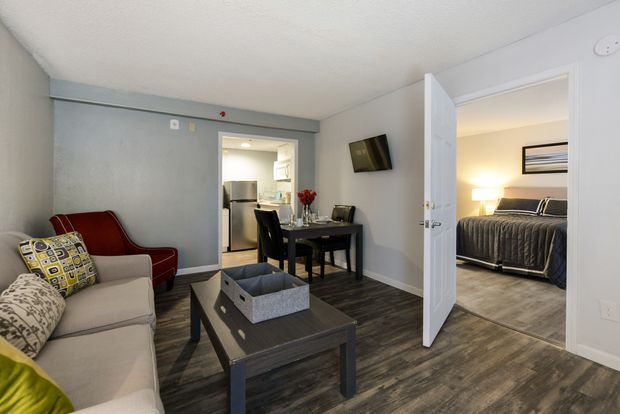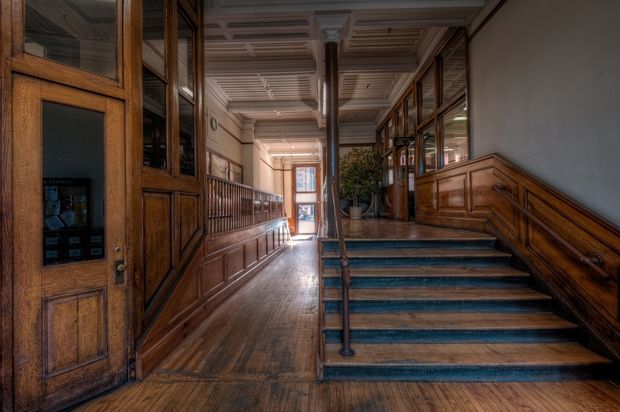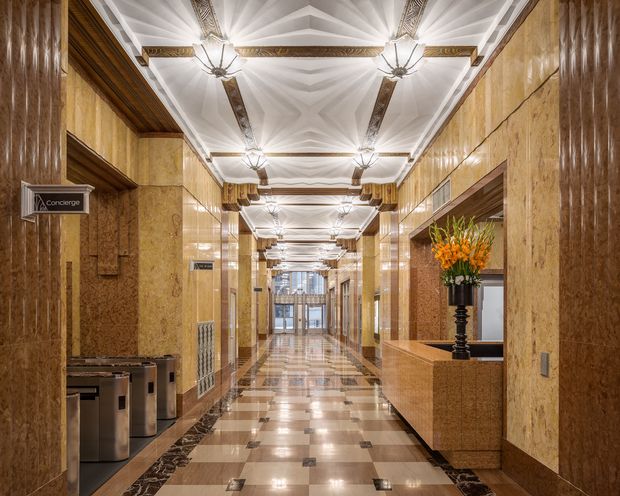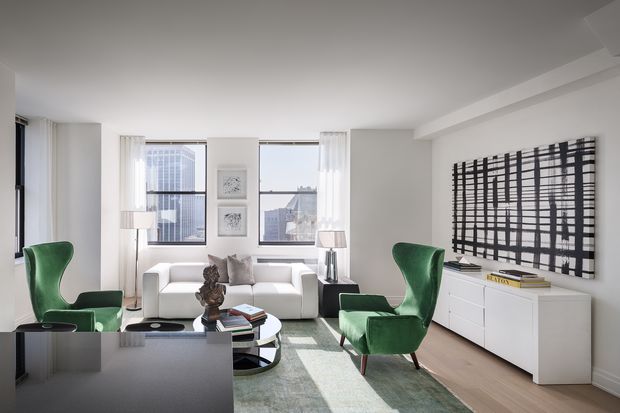The real estate market has two growing problems: a serious short-age of affordable housing, especially for renters, and hospitality and office buildings in distressed states because of COVID-19.
Could the second challenge offer a solution for the first?
“We should convert vacant commercial space to supportive and affordable housing, and we should do it now,” New York Gov. Andrew Cuomo has said.
Retrofitting real estate for a new purpose is not a new concept, but the strains of the pandemic bring new light to the concept.
that helps create a diverse skyline.
Photo: Stephen…”>
Manhattan’s historic 70 Pine is a protected, office-to-residential conversion
that helps create a diverse skyline.
Photo: Stephen B. Jacobs Group
“Adaptive reuse is as old as real estate,” said Richard Rubin, CEO of Repvblik, a Los Angeles–based developer that converts commercial real estate into housing.
Hotels are one ‘affordable’ solution
Repvblik bought a 400-room former Days Inn complex in Branson, Mo., for conversion into studio and one-bedroom apartments. Since the property was purchased in April 2018, the company has completed two of the six residential buildings as well as a clubhouse with a gym and a pool. The property, called Plato’s Cave, is approaching 50% occupancy in its completed portions. Rents range from $495 for a studio apartment to $625 for a one-bedroom unit.
Rubin’s company has recently acquired a shuttered Ramada Inn in northern Alabama that it plans to convert into 120 one-bedroom housing units as a joint venture with Drever Atelier Partners. Repvblik is targeting late summer 2021 for the first phase to open, with rents below $600 a month. Repvblik plans to begin under-writing deals on office conversions as well. Rubin expects there will
be significant distress in the office market starting later this year into 2022 and beyond, bringing buying opportunities.

In this Branson, Mo., Days Inn apartment conversion, renamed Plato’s Cave, rents range from $495 for a studio to $625 for a one-bedroom unit.
Photo: Plato’s Cave
Prior to COVID-19, real estate investment crowdfunding marketplace RealtyMogul Co. had tracked a lone transaction featuring a hotel-to-multifamily conversion, according to its CEO, Jilliene Helman. By February of this year, RealtyMogul had seen five additional transactions of this type submitted to its platform, though the company opted not to pursue deals in those cases. Earlier this year, the company had a deal go live featuring the historic mill Everett Mills, in Lawrence, Mass., which is being converted into a development featuring what it bills as affordable multifamily units and renovated office space and other mixed-use.

The lobby at Everett Mills, in Lawrence, Mass. The mixed-use development 25 miles from Boston has parking on site and at an adjacent 860-space deck. It is walking distance from the commuter railway.
Photo: Robert Lussier
“We’re actively looking for hospitality-to-multifamily conversion,” Helman said. “They are going to be, in general, more affordable than other multifamily in the submarket, because the floor plates are smaller.”
According to Helman, it’s conceivable that a hotel could be purchased for around $40,000 a unit and the same amount put into refurbishments, and then be sold for $120,000 a unit. One factor making these conversions so affordable is the over-lap between hotel and apartment design: plumbing and unit layouts often remain untouched, so generally a kitchen update and overall refresh are all that’s needed.
Hotel economics have shifted in favor of these projects in the wake of the pandemic.
“Most well-located hotels were not in distress pre-COVID — they were performing,” Helman said. But with tourists largely staying home, whether by choice or by government mandate, many hotel operators are struggling, particularly smaller, independent operators that do not have access to the cash reserves that chain hotels do.
Over 3,100 commercial mortgage-backed securities — representing some $87 billion in debt — are backed by hotel properties across the U.S., according to real estate data firm Trepp LLC. Lodging is the third- largest property type in the CMBS universe by outstanding balance. In June 2020, the lodging sector’s delinquency rate hit a record high of 24.3% before falling back to 19.43% by autumn. In some metro areas, the delinquency rate was much higher. In Houston and Chicago, Trepp reported, over half of the outstanding balance for hotels was delinquent as of November.
Over a third of the outstanding balance of lodging-related debt is scheduled to mature by the end of 2021, which could compound the sector’s issues at a time when revenue has dropped by upwards of 60% per available room on an annual basis.
Tougher conversion
While politicians may devote attention to converting office space into housing, the sector has remained relatively resilient for now. The delinquency rate for office CMBS was only 2.5% as of October. Companies continue to sign leases — but that is expected to change over time, on a localized level, analysts say. The pandemic accelerated a shift to the suburbs and an embrace of work-from-home technologies that could stress office-building occupancy in major cities.
“Companies are realizing that all work does not have to be done at the office,” said Nick Bailey, chief customer officer at RE/MAX.
Converting an office building into apartments is, in most cases, more complex than a hospitality-to-apartments conversion.

Converting offices at 70 Pine into apartments while respecting preservation requirements was difficult and turned some developers away, says architect Stephen Jacobs.
Photo: Stephen B. Jacobs Group
“Sometimes the stairs and elevators happen to be in a workable location,” said Stephen Jacobs, founder and president of the Stephen B. Jacobs Group, an architecture and planning firm that specializes in adaptive-reuse projects. “But sometimes to make the building efficient they have to be relocated. It’s very, very much building-specific.”
In one project Jacobs completed — 70 Pine St. in Manhattan — part of the challenge was the building’s podium, or base. It’s a New York landmark, meaning it could not be significantly altered.
“How to convert that podium into apartments without demolishing a piece in the building was extremely difficult,” he said. “A lot of people passed on that building because they didn’t know how to do it.”
“ ‘Today, the office buildings that we’re talkingabout converting … they’re 90 cents on thedollar. The existing real estate has not gottencheap enough yet.’ ”
Indeed, a lack of expertise in adaptive reuse could prevent it from becoming a mainstream approach in the near future. It isn’t difficult to find architects and builders who know how to tear down and rebuild from scratch. It’s an entirely different proposition to gut an office building from the inside while maintaining the exterior.
“One of the reasons why it’s easy to build suburban houses is because everybody knows how to do it right,” said Adam Ducker, CEO of real estate advisory firm RCLCO. “The construction companies can price it very aggressively because they know exactly what they’re doing. Converting these buildings is full of unknowns and risk.”
With fewer construction firms to choose from, developers often are forced to spend more. That makes the economics of adaptive reuse particularly challenging, especially given the prices that commercial real estate is still fetching.
In New York, for instance, the total market value for commercial properties — including everything from warehouses to hotels — fell 15.7% between 2020 and early 2021, to $274.6 billion, or roughly $233 per square foot, according to the city’s Department of Finance. Office-building values dropped in line with the overall average for all commercial real estate, falling 15.6% from 2020, whereas the value of retail buildings and hotels declined roughly 20%.

The adaptive-reuse of the former offices at 70 Pine in Manhattan features studios up to four-bedroom apartments.
Photo: Stephen B. Jacobs Group
A Department of Finance spokesperson noted that the property values the agency uses are collected for the purpose of property taxation, making them different from the market value. Still, the figures show that the pandemic has not rendered these real-estate assets virtually worthless.
“Today, the office buildings that we’re talking about converting — even after COVID, with all the uncertainty — they’re not worth pennies on the dollar; they’re 90 cents on the dollar,” said Ducker, who is also vice chair of the Urban Land Institute’s Redevelopment and Reuse Council. “The existing real estate has not gotten cheap enough yet.”
Proponents of adaptive reuse contend there are other savings to consider. “We’re all talking about conserving energy and are concerned about our carbon footprint,” Jacobs said. “Throwing away buildings is a waste of energy. Every brick that already exists, it doesn’t take energy to produce it.”










Add Comment